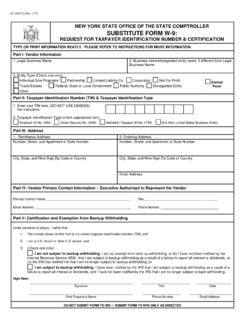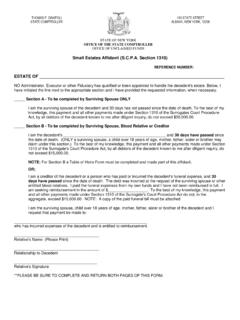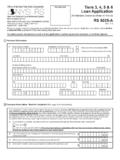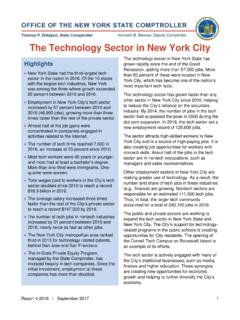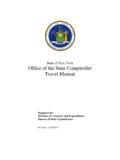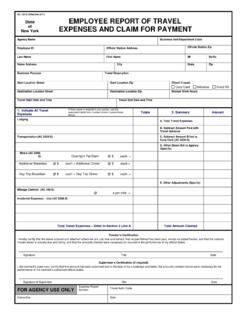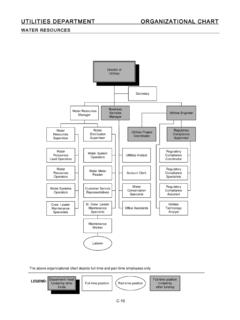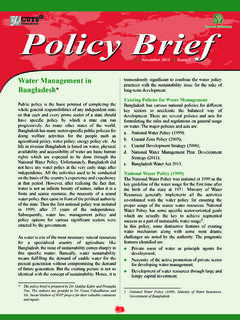Transcription of Federal and New York State Regulation of Drinking Water ...
1 Federal and New York State Regulation of Drinking Water Contaminants June 2017 Message from the Comptroller June 2017 It s easy to take clean, safe Drinking Water for granted. However, as incidents of contamination in our public Water supplies in recent years have reminded us, strong regulatory oversight is essential to assure the quality and safety of our Water . The Safe Drinking Water Act, enacted by Congress in 1974, assigns responsibility for Regulation of public Water supplies to the Federal Environmental Protection Agency (EPA) and to State governments. As a result of that law, the EPA has set binding standards that limit the concentrations of certain substances in Water supplies nationwide, and has established advisory limits for some other contaminants. states have a key role as well: they can impose more strict limits than the EPA s, or establish standards for substances that the Federal government does not regulate.
2 In New York, the State Department of Health has taken those steps with regard to a number of contaminants. Yet the current Federal - State regulatory structure can leave significant gaps in protections for New Yorkers. News of Water contamination in places such as the City of Newburgh and the Village of Hoosick Falls shows the vulnerabilities that may arise as a result. Several measures included in New York s State Fiscal Year 2017-18 Enacted Budget are intended to enhance protection of public Water supplies and the State s ability to respond to future contamination events. Unfortunately, the new Administration in Washington has proposed actions by the Federal government that could weaken safeguards for Water consumers. The EPA s ability to implement the SDWA effectively may be threatened by the Administration s plan to cut the agency s budget by nearly a third. Ensuring that Drinking Water supplies are free from hazardous contaminants is a complicated challenge, with important implications for public health as well as for State and local government budgets.
3 This report outlines a variety of steps that Federal and State policy makers could consider in working to meet that challenge. Such items include enhancing information for the public, establishing a more effective Federal - State regulatory partnership, strengthening State Regulation where appropriate, and expanding capacity to identify and respond effectively to contamination incidents. New Yorkers support their public Water systems through taxes and fees, and expect clean, safe Water when they turn on the tap. While both the State and Federal governments have done much to ensure that result, further efforts are essential. Thomas P. DiNapoli State Comptroller Table of Contents I. EXECUTIVE SUMMARY .. 1 II. INTRODUCTION .. 4 III. HISTORY OF THE SAFE Drinking Water ACT .. 6 Initial Passage .. 6 1986 and 1996 Safe Drinking Water Act Reauthorization .. 6 Federal EPA Process for Regulating Contaminants .. 7 IV. NEW YORK State S Regulation OF Drinking Water CONTAMINANTS.
4 11 New Initiatives to Promote Safe Drinking Water .. 12 V. PUBLIC Water SYSTEM REPORTS ON Water QUALITY .. 14 VI. POTENTIAL ACTIONS TO PROTECT Water USERS .. 15 Federal Actions .. 15 State and Local Actions .. 16 VII. CONCLUSION .. 18 I. Executive Summary Laws and regulations implemented over decades by the Federal and State government are intended to assure clean, safe Drinking Water for New Yorkers. In recent years, however, contamination of Water supplies in certain communities has raised questions as to whether existing oversight is adequate and effective. This report summarizes the current Regulation of public Water supplies and outlines potential steps to enhance such oversight for the benefit of individuals and communities throughout New York. The Federal Safe Drinking Water Act (SDWA), enacted in 1974, provides the statutory basis for Federal and State regulations governing the operation of public Water systems, including concentrations of contaminants in Drinking Water .
5 The Environmental Protection Agency (EPA) sets national standards and has implemented broad regulatory processes, as well as specific directives relating to certain chemicals, pursuant to the law. The SDWA includes a key role for State governments to play in ensuring safe Drinking Water , allowing individual states to set and enforce their own standards that are at least as stringent as the EPA s national rules. New York statutes and regulations give the State Department of Health (DOH) authority to implement Federal law and regulations, and to issue State -level rules governing public Water systems. The current Federal - State regulatory structure requires a strong partnership between the two levels of government, and can leave significant gaps in protection. In some cases, the State has adopted standards for Water contaminants that are identical to or stricter than the EPA s, or established regulations where Federal rules do not exist. In other cases, the EPA has recommended non-binding health advisory levels and encouraged states to use such guidance in their efforts to keep Drinking Water safe.
6 However, there are instances in which the binding standards set by the DOH are not as protective as EPA health advisory levels, or where the DOH has opted not to establish regulatory standards consistent with EPA guidance. Since enactment of the SDWA, the EPA has established national primary Drinking Water standards for 88 contaminants and groups of contaminants. However, it has not added final regulations for any additional contaminants in more than two decades. Water contamination incidents in the Village of Hoosick Falls and the City of Newburgh illustrate the vulnerabilities of the current regulatory structure. In Washington, the new Administration s proposal to cut the EPA s budget by nearly one-third, and its intent to reduce environmental regulatory oversight, raise further concerns regarding the agency s ability to implement the SDWA effectively. Ensuring that public Drinking Water is safe and clean is a significant challenge, given the thousands of chemical contaminants that may be present in Drinking Water and the incomplete scientific understanding of potential health impacts from many of these 1 substances.
7 Several measures in the State Fiscal Year 2017-18 Enacted Budget are intended to address contaminants that are not regulated at the Federal level and to provide new resources to clean up contamination and protect Drinking Water sources. For example, DOH will be required to identify certain substances as emerging contaminants. Water systems that serve certain numbers of consumers will be required to test for such contaminants at least every three years, and to notify DOH and local property owners of the results of such testing when concentrations reach certain levels. In such cases, DOH is empowered to require that Water systems take action to reduce exposure to the contaminants. Other provisions in the Budget include $ billion for clean Water infrastructure projects, with some of that funding directly addressed to prevention or remediation of Water contaminants. Given the importance of assuring clean Water , the Federal government and New York State should consider additional steps to protect public Water systems and their consumers more effectively, including: Enhancing information to the public in annual Drinking Water quality reports.
8 Operators of Drinking Water systems should provide information on the health impacts of contaminants found in the Water they provide. In addition, the State should report regularly on trends in Drinking Water quality and implications for public health. DOH could also provide readily understandable information about relevant laws, regulations and current scientific findings, as the EPA does now. Establishing a more effective Federal - State regulatory partnership. The necessary first step for Federal policy makers is to commit to moving forward, rather than backward, in keeping Drinking Water safe. Such a commitment would require adequate funding, including resources to implement the SDWA. Meanwhile, the EPA should move more decisively to develop regulations for contaminants found in Drinking Water . To meet the difficult challenge of reducing risks from exposure to Water contaminants, Federal and State officials should work cooperatively, in areas such as maintaining up-to-date information on the condition of local Water systems and providing technical assistance to such entities.
9 Strengthening State Regulation where appropriate. In considering standards under its new emerging contaminants program, DOH should consider whether explicit adoption of a more precautionary approach to regulating contaminants is appropriate. While the State regulatory process moves forward, policy makers should consider EPA advisory guidance, existing State standards for contamination of other environmental media, or relevant standards in effect in other states to develop interim responses to protect public health. State policy makers could consider whether New York binding standards should be at least as restrictive as those set out in EPA s advisory levels. Expanding existing Water testing to more contaminants. Under newly enacted statutory requirements, DOH will identify currently unregulated contaminants as candidates for required sampling by New York Water systems. In addition to criteria that are statutorily required under the new emerging contaminant program, data from the Toxic Release Inventory, historic land use records, hazardous waste generation permits and results of prior sampling performed under established 2 regulations should be evaluated to identify potential contaminants and guide the expenditure of State resources and potential regulatory actions.
10 Establishing more effective systems for responding to hazardous levels of contamination. To assure prompt, consistent and effective responses, the State should prepare and publish an overall plan including measures that may be implemented when future contamination events occur. Creating a State health monitoring program. In Hoosick Falls and Newburgh, the State created health monitoring programs on an ad hoc basis in response to local concerns. Establishing ongoing protocols for such programs, including consideration of potentially necessary funding, would better ensure effective responses in the future. New Yorkers need clean Drinking Water . While both the State and the Federal government have done much in recent decades to minimize the possibility of unsafe contamination in our Drinking Water , further and more effective efforts are II. Introduction Clean, safe Drinking Water is critically important for New Yorkers health and for the State s economic growth and prosperity.
